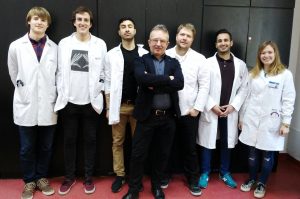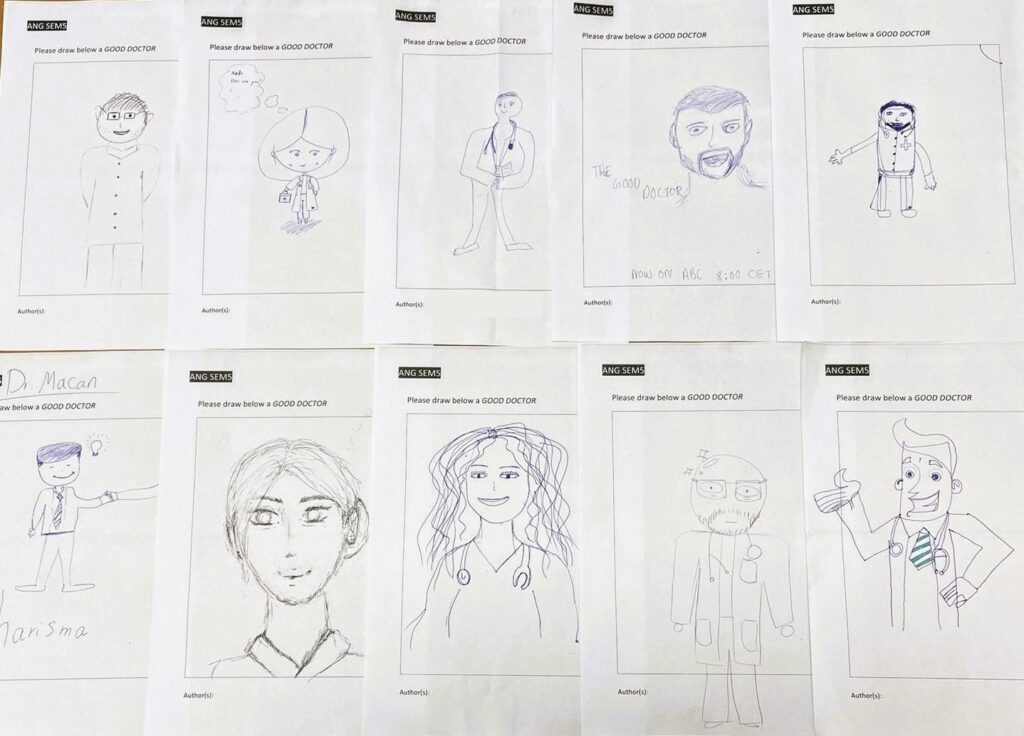Curriculum

* Student group from the 2016 rotation *

* Good doctors according to one of the 2024 rotation *
In the 2024/2025 academic year, the entire rotation in Family Medicine comprises 130 hours.
Detailed timetable for each rotation will be distributed at the first day of rotation. The first day starts with the seminar starting at 8:15.
NOTE: Before entering the room, students may have their body temperature measured. Increased body temperature (> 37.0 ° C) and / or other symptoms characteristic of a respiratory tract infection will be the basis for not allowing the student to attend seminars/classes (without losing attendance on a given day).
Seminars take place in the Department’s venue, whereas classes take place in a number of GP practices (details will be provided in the timetable). At both classes and seminars, students are obliged to wear badges. Students being late by more than 15 min. at the meeting will not be allowed to take part in the classes or seminars. When being to the GP practice, please do not leave or enter the room while the visit with patient is ongoing. Please do not eat or drink during the clinical class. Individual measures to protect from COVID-19 are of sole responsibility of a student, and are compulsory to take part in the classes.
Details of seminars and classes:
A. Seminars (in non-chronological order) – start every day at 8:15:
1. Principles and core values of family medicine. PDF>>
(suggested literature: Sloane PD. Essentials of Family Medicine, Chapter 2)
2. GP and other levels of healthcare system: co-operation or competition? PDF>>
3. Prevention in family medicine. PDF>>
(suggested literature: Sloane PD. Essentials of Family Medicine, Chapter 8, U.S. Preventive Services Task Force Pocket Guide to Clinical Preventive Services 2005, link>>, Conroy RM et al., Estimation of ten-year risk of fatal cardiovascular disease in Europe: the SCORE project. Eur Heart J. 2003 Jun;24(11):987-1003. link>>)
4. Practice organization and financing in Poland and the other countries. PDF>>
(suggested literature: Sloane PD. Essentials of Family Medicine, Chapter 4)
5. Doctor-patient communication. PDF>>
(suggested literature: Herxheimer A (2005) Communicating with Patients about Harms and Risks. PLoS Med 2(2): e42 link>> )
6. Conflict prevention and solving in family medicine. PDF>>
(suggested literature: Sloane PD. Essentials of Family Medicine, Chapter 5)
7. Chronic conditions in family doctor’s practice. PDF>>
8. Pharmacoeconomics in family doctor’s practice. PDF>>
(suggested literature: King DR, Kanavos P. Encouraging the use of generic medicines: implications for transition economies. Croat Med J. 2002 Aug;43(4):462-9. link>> , Moghimi Y (2006) The “PharmFree” Campaign: Educating Medical Students about Industry Influence. PLoS Med 3(1): e30 link>>, Almasi EA, Stafford RS, Kravitz RL, Mansfield PR (2006) What Are the Public Health Effects of Direct-to-Consumer Drug Advertising? PLoS Med 3(3): e145 link>>, Caulfield T (2004) The Commercialisation of Medical and Scientific Reporting. PLoS Med 1(3): e38 link>>, Applbaum K (2006) Pharmaceutical Marketing and the Invention of the Medical Consumer. PLoS Med 3(4): e189 link>>)
9. Use and misuse of medication. Rational use of antibiotics. PDF>>
(suggested literature: Waller DG. Rational prescribing: the principles of drug selection and assessment of efficacy. Clin Med 2005; 5: 26-8., Barter PJ, Rye K-A, Gotto AM, Jr. The Argument Against the Appropriateness of Over-the-Counter Statins. Circulation 2006;114;1315-1320. link>>, Gotto AM, Jr, Barter PJ, Rye K-A. Over-The-Counter Statins Are Worth Considering in Primary Prevention of Cardiovascular Disease. Circulation 2006;114;1310-1314. link>>, David M. Wong, Dean A. Blumberg i Lisa G. Lowe. Guidelines for the use of antibiotics in acute upper respiratory tract infections. Am Fam Phys 2006;74:956. link>>, Patrick DM, Hutchinson J. Antibiotic use and population ecology: How you can reduce your “resistance footprint” CMAJ, FEBRUARY 17, 2009; 180(4) link>> )
(suggested literature: Kardas P. Patient compliance with antibiotic treatment for respiratory tract infections. J Antimicrob Chemother. 2002 Jun;49(6):897-903. link>>,)
10. Adherence to medication. PDF>>
(suggested literature: Kardas P. Patient compliance with antibiotic treatment for respiratory tract infections. J Antimicrob Chemother. 2002 Jun;49(6):897-903. link>>,)
11. End of life issues. PDF>>
12. Alternative treatment. PDF>>
(suggested literature: Nienhuys JW. The True Story of Oscillococcinum link>> metaanalysis on acupuncture link>>)
13. Vaccinations in primary care. ECG. PDF>>
(suggested literature: Kadish et al., ACC/AHA clinical competence statement on electrocardiography and ambulatory electrocardiography .J Am Coll Cardiol 2001; 38: 2091-100. link>>)
14. Respiratory tract conditions: COPD, asthma, RTIs. PDF>>
15. Elderly care. PDF>>
16. Mental health issues and related drugs of use in primary care. PDF>> *
B. Classes (in alphabetical order):
-
- Abdominal pain
- Chest pain
- Child & newborn care
- Diabetes mellitus global guidelines for DM2>>
- Dyspepsia and other digestive tract diseases
- Dysuria
- Fever
- Headache
- Hypertension
- IHD
- Lower back pain
- Obesity
- Otoscopy
- Prenatal care
- RTIs
- Skin problems
Basic suggested literature:
Principal handbook:
P. D. Sloane, Essentials of Family Medicine, 6th ed., Lippincott Williams & Wilkins 2011, ISBN 1608316556
(NB. A newer, 7th edition is also available. Because there is certain difference in chapters between 6th and 7th edition, please use the 7th edition for the topics which are not covered by the 6th edition.)
Assessment methods and criteria:
A. knowledge component
- multiple choice test
B. skills component
- a case study (a template is available here>>)
- ongoing evaluation of practical skills for primary diagnosis of a child and an adult, made by the teacher leading the clinical meeting
C. attitudes and transferable skills component
- ongoing evaluation of ethical and transferable skills, made by the teacher leading the clinical meeting, with clinical evaluation form
The scoring system is based on points that students are supposed to earn according to their results.
The exam is based on multiple choice test (80 points), its value is 80% of final total score. Example of test questions are provided here>>
Up to 20% of total final score could be collected for attendance at seminars and classes. Attendance at seminars will be recorded by your teacher at random time. NB make sure that you collect enough points to pass the exam. No chances to attend the meetings after the end of the rotation will be provided to the students.
The final mark is given according to the total score: 67-75p – 3, 76-81p – 3.5, 82-87p – 4, 88-93p – 4.5, 94-100p – 5. Here is the calculator of the final grade.
Caution: 75% of attendance necessary to take the exam
NB Students trying to cheat with their attendance, by providing their charts for signature, while in fact they were absent, will be given negative points for attendance. No retrospective collection of signatures is allowed.
Note: questions regarding test results, test questions etc. are accepted within two weeks’ time from the date of exam.
Registration for the exam takes place at https://www.terminy.umed.asksys.pl/en/ no later than 2 days before the date of the test. Students need to register in advance. No registration means no entrance to the exam! In case of technical problems with logging in for the exam, please contact Ms Magdalena Jarzyńska (an employee of the Central Examination Center) at the email address: egzaminy@umed.lodz.pl. Other organizational issues related to exams are regulated by the Regulations of the Central Examination Center.
The test is carried out on computers at the Clinical Didactic Center at Pomorska 251 Street in Łódź. 24 hours before the exam each registered student will get a confimation of date, hour and room of the exam. These details may change, because they depend on final number of registered students, so please do check them before the exam.
Dates of the exams are:
- Winter semester 2024/25:
- I term – January 27th, 2025 RESULTS>>
- First retake – February 25th, 2025
- Second retake – March 5th, 2025
- Summer semester 2024/25:
- I term – June 17th, 2025
- First retake – September 10th, 2025
- Second retake – September 18th, 2025
Historic results:
- …
Students need to register in advance. No registration means no entrance to the exam!
24 hours before the exam each registered student will get a confimation of date, hour and room of the exam. These details may change, because they depend on final number of registered students, so please do check them before the exam.
Sick leaves: Sick leaves must be presented within 5 days of the termination of the sick period, in original paper version. Sick leave document must be issued, or translated into Polish or English, to be deemed valid. The sick leave should be sent by email to the coordinator at the Dean’s Office in order to have it added to the electronic student record. It is not necessary to send it to the Department of Family Medicine.
According to the Rules and Regulations of the Medical University of Lodz:
“§ 26. Point 1. The student who has failed to sit a credit test or examination on the date arranged beforehand has to present a medical certificate issued by a doctor or, in justifiable cases, another written justification to the course coordinator, not later than within 5 working days after the reason for their absence ceased.”
IMPORTANT: From the beginning of the summer examination session (i.e. from June 16, 2025), students will be required to submit their medical certificates in accordance with the following rules:
The medical certificate must include all of the following elements:
- the date of issuance of the document;
- the physician’s full name;
- a physician’s stamp confirming the physician’s qualifications and medical specialisation(s);
- the medical license number;
- the physician’s handwritten signature;
- the student’s full name;
- the student’s PESEL number or passport number (if a PESEL number has not been assigned);
- the period of validity of the medical certificate;
- the purpose or reason for the issuance of the certificate.
The following types of medical certificates will NOT be accepted:
- certificates issued on the ZUS ZLA form. This certificate format applies to individuals employed under an employment contract and cannot be used by students to justify absences from classes, assessments, or examinations;
- certificates issued electronically during teleconsultations;
- certificates issued through automated prescription platforms (so-called “receptomats”).
Recommendation letter: recommendation letter might be issued for a student, in response to individual request, provided that the student has passed final exam at the first attempt, and received final mark of 4.0 or above
Contact regarding didactic issues: Pawel Lewek MD PhD>>


